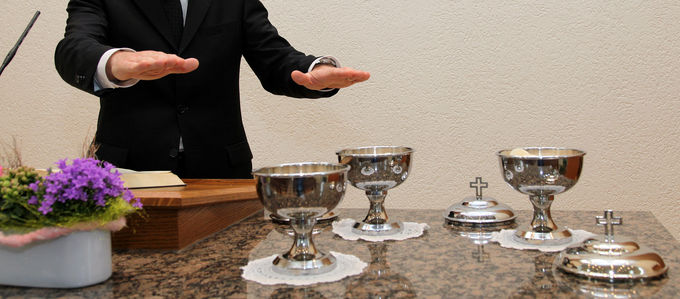
The Holy Communion debate between the churches is centuries old. What happens, and what does not? These questions attest to just how great the mystery of Christ’s presence in His church really is. How does the New Apostolic Church see this?
The sequence of our liturgy steers the way toward the high point of the divine service: Holy Communion is to be celebrated as a solemn, exalted, extraordinary event in the divine service. The congregation is prepared: some introductory words about remorse and repentance are spoken, a hymn of repentance is sung by the congregation, the Lord’s Prayer is prayed collectively, the absolution is pronounced, and the Eucharistic prayer is spoken.
This is followed by moments of silent pause. This is the time that is utilised for the visible and perceptible removal of the communion chalice (or paten) lids. This is done with the greatest possible calm and dignity. Up until the absolution, the congregation is a repentant one, but thereafter it is a purified congregation. And it is precisely at this moment that the most holy is opened up: the elements of Holy Communion are unveiled. And this is something the congregation is to experience in full awareness.
The table of the Lord is prepared
This uncovering of the wafers is an extremely solemn act—the congregation is supposed to see it! The table of the Lord is now prepared. The Priest now extends his arms, holds his hands over the chalices in a gesture of blessing, and speaks the solemn words of the consecration formula:
“In the name of God, the Father, the Son, and the Holy Spirit, I consecrate bread and wine for Holy Communion and lay thereupon the once brought, eternally valid sacrifice of Jesus Christ. For the Lord took bread and wine, gave thanks and said: ‘This is My body which is broken for you. This is My blood of the new covenant given for many for the remission of sins. Eat and drink! Do this in remembrance of Me.’ For as often as you eat this bread and drink this wine, you proclaim the Lord’s death till He comes. Amen!”
Jesus Christ has now entered into His congregation. Through the words of the Priest, the body and blood of Christ are joined to the bread and wine. God is present!
The words of the consecration are recorded primarily in 1 Corinthians 11: 24–26. In this passage, Apostle Paul cites the words of Jesus and describes the content of Holy Communion in principle. It is a solemn and exalted moment. Through consecration, the bread and wine have been set apart from their usual use. Through the spoken words of institution, the invisible presence of Christ’s body and blood becomes possible in the visible elements of bread and wine. The bread and wine are not changed in their substance as a result. Rather, another substance is joined to them, namely that of the body and blood of Christ (consubstantiation). There is no change in the substance of these elements (transubstantiation).
No change, but more than a symbol
And this is precisely the point on which opinions in the various denominations diverge. Some celebrate a change in substance, but for others the event is only symbolic. The New Apostolic understanding of Holy Communion states that, while there is no change in substance, the event is more than merely a symbol. The bread and wine are not merely metaphors for the body and blood of Christ. Rather, the body and blood of Christ are truly present (real presence). Through the words of consecration, the substance of Christ’s body and blood are joined to the substance of bread and wine. The outward form (accidence) of the Holy Communion elements does not change as a result of this event.
The Son of God is now truly present in the elements of Holy Communion. And He remains present for as long as it takes for the elements to reach their intended recipients.
Photo: Frank Schuldt




